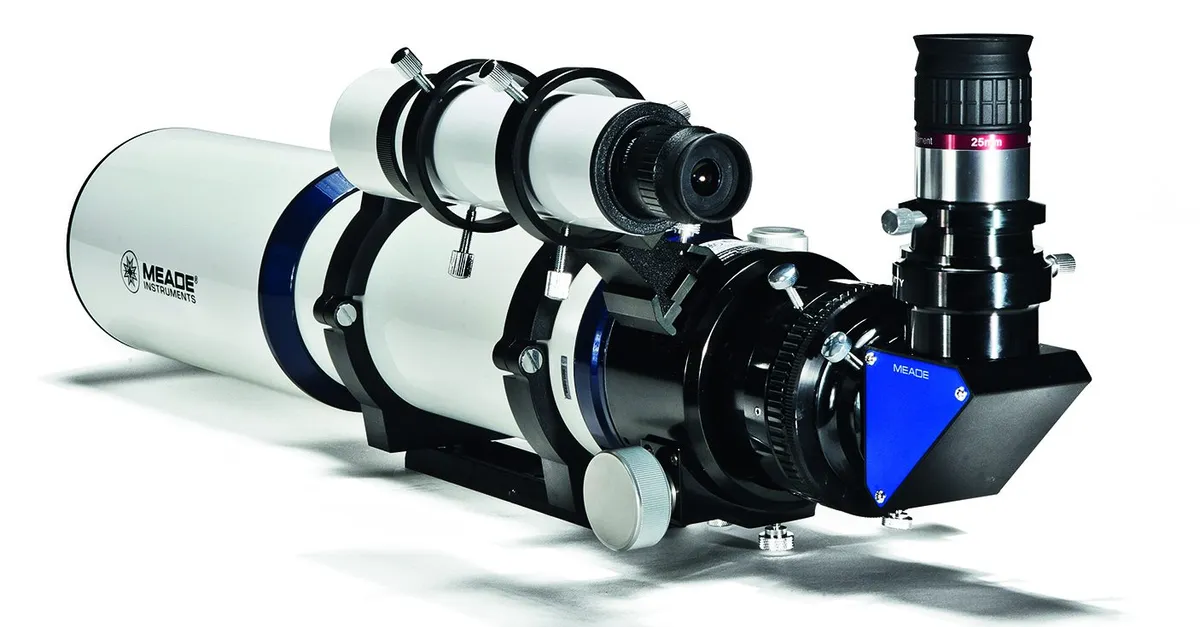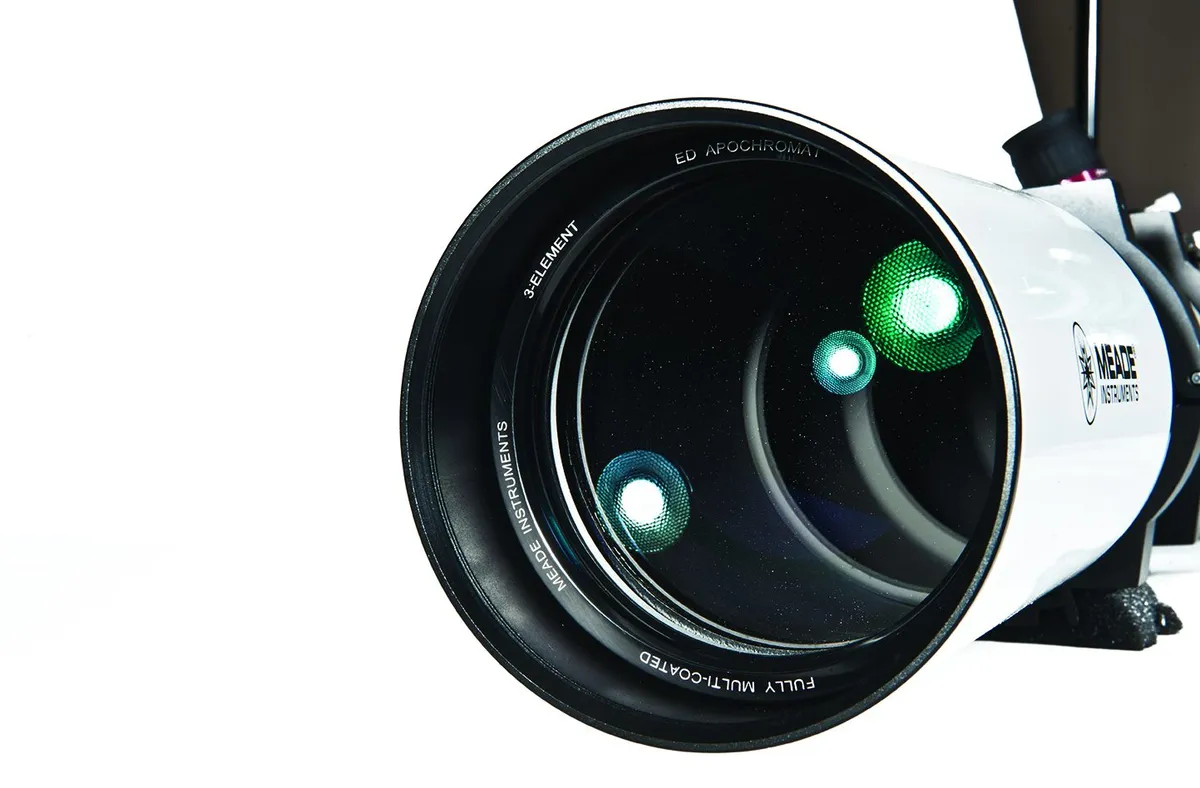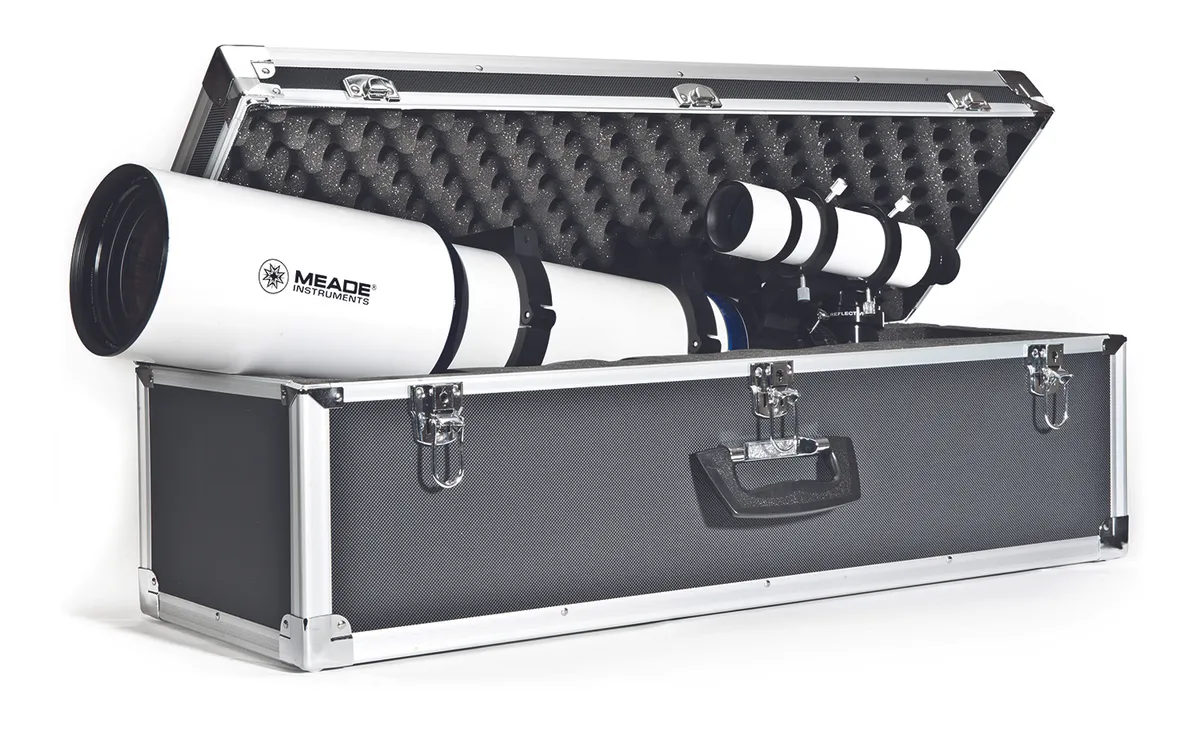The Meade Series 6000 115mm apochromatic refractor is designed for both visual and photographic astronomy. It uses a three-element, air-spaced lens to deliver high-contrast and colour-corrected views.
If you look at a bright target through a telescope that uses a single-element lens, it will typically be surrounded by a ring of colour.
This occurs because the lens acts a bit like a prism, spreading light into its individual colours, each of which comes to focus at a slightly different distance from the lens. Known as chromatic aberration, this typically manifests itself as a blue or violet fringe around the edge of bright objects.
Adding an additional lens element creates a doublet lens, which brings two colours, usually red and blue, to a single focus and reduces the effect.
This Meade refractor goes one better with an air-spaced triplet lens made from extra-low dispersion glass.
This design reduces unwanted colour aberrations further still, bringing yet another colour – typically green – to focus along with the red and blue.
The net result is a scope that delivers lovely crisp stars free from any distracting colour fringing.
In addition, the incoming light path in a refractor is unobstructed, unlike in a reflector (which uses mirrors) or a compound scope (which uses a combination of lenses and mirrors).
If the scope has been designed correctly, this translates into a view that has extremely high contrast. Star fields appear like scattered diamonds on black velvet, while views of the Moon and planets are rich, crisp and detailed.
This telescope features in our guide to the best telescopes for observing planets

In the middle
This scope is attractive and well-constructed. Its retractable dew shield and foam-lined carry case also make it fairly easy to move about.
Tube rings are supplied with a Vixen-Synta style dovetail plate fitted. A high-quality 2-inch star diagonal, 2-inch eyepiece and 8x50 finderscope are also included.
It has a focal ratio of f/7, so it’s mid way between being fast and slow. Fast instruments have smaller focal ratios and are great for wide-field views.
Slow scopes have larger f/ratios and are suited to close-ups of the Moon and planets. You can work out the f/ratio by dividing the scope’s focal length (805mm in this case) by its aperture.
Through the 25mm eyepiece the core of the Andromeda Galaxy, M31, looked like an elongated smudge, as it always does through small instruments, but the two satellite galaxies, M32 and M110, were beautifully presented either side of it.
The stars near the edge of the field of view remained crisp and undistorted.
The Dumbbell Nebula, M27, in Vulpecula, looked exquisite, its apple-core shaped disc floating in a sea of intense point-like stars.
We were also entranced by the view we had using lower-power eyepieces. These helped to maintain the contrast advantage of the scope. Higher magnification eyepieces took us closer to the action but with lower contrast.
The famous Double-Double, Epsilon Lyrae, presents a decent test for small scopes: a wide pair of stars, each a close double itself.
The scope fared really well here, convincingly splitting both tight pairs using our own 9mm eyepiece.
The scope didn’t let us down when it came to imaging either. The dual-speed Crayford-style focuser allowed us to snap to focus with ease and can be rotated too, allowing you to orientate your subject perfectly.
The images we achieved had pin-sharp stars in the centre of our DSLR shots, but did show a slight elongation towards the corners of the frame.
This isn’t that unusual and something that you may be able to address with a field-flattener, though we didn’t test this.
This is a great all-round instrument that gives crisp, high-contrast views and is useful for visually observing both deep-sky and Solar System objects.
It is also well suited to astrophotography and produces very acceptable images.

Triumphant triplet
The quality of the image delivered by this apo refractor is impressive both photographically and visually.
This is due to the scope’s air-spaced triplet objective, which is fully multicoated, ensuring that the view delivered is bright, vibrant and shows excellent contrast.
The scope has a focal length of 805mm (f/7), so it can produce reasonably wide views with a low-power eyepiece.
It’s at low magnifications that the triplet lens really shines, producing intense point-like stars scattered across the field of view.
At higher magnifications, defocusing the scope on brighter stars revealed a set of diffraction rings that were perfectly concentric with one another.
This is a good test for problems with a scope’s optics and we’re happy to report that the Meade’s triplet gave us no cause for concern here.
Another demanding test for any objective lens is a bright Moon. Colour fringing, if present, becomes apparent where the edge of the Moon’s bright surface meets dark shadows or the black background of space.
Once again, the excellent triplet passed without issue.

Star diagonal
A good-quality 2-inch diagonal is supplied as part of the package. The diagonal diverts the light path through an angle of 90º, allowing you to put the eyepiece into a comfortable viewing position. With a quoted reflectivity of 99 per cent, the diagonal retains the scope’s high contrast view.
Objective lens
This refractor has an aperture of 4.5 inches. The main lens is an air-spaced triplet, which is made of multicoated, extra-low dispersion glass to keep chromatic aberrations to a minimum. In tests, we struggled to see any colour fringing around the edge of bright stars or the Moon.
Focuser assembly
The 3-inch Crayford-style focuser includes fittings for 2-inch and 1.25-inch adaptors. The rear of the focuser rotates independently of the main body, a useful feature that allows you to orientate a camera to the best framing position. The lockable focuser has both rough- and fine-focus knobs.
8x50 finderscope
The finderscope supplied has a diameter of 50mm and offers 8x magnification. It’s supported by two guide rings, each with three adjustment screws. The finder attaches to the rear focuser assembly and the whole unit can be rotated independently of the main tube. Consequently, the finder can always be placed in a convenient position for use.
Portability
The telescope comes fitted with tube rings attached to a Vixen-Synta style dovetail plate, a standard used on many mounts. A sturdy, foam-lined carry case is also included. For ease of transportation, the scope’s dew shield can be retracted. It’s locked in position by a thumbscrew.
Vital stats
- Price £1,599
- Optics FK61 fluro-crown glass triplet apo
- Aperture 115mm (4.5 inches)
- Focal length 805mm
- Focal ratio f/7
- Focuser Crayford-style 3-inch with dual speed 10:1 ratio
- Extras 2-inch dielectric diagonal, 25mm eyepiece, tube rings, carry case
- Weight 7.9kg
- Supplier Telescope House
- Tel 01342 837610
- www.telescopehouse.com
This review originally appeared in the January 2013 issue of BBC Sky at Night Magazine.
